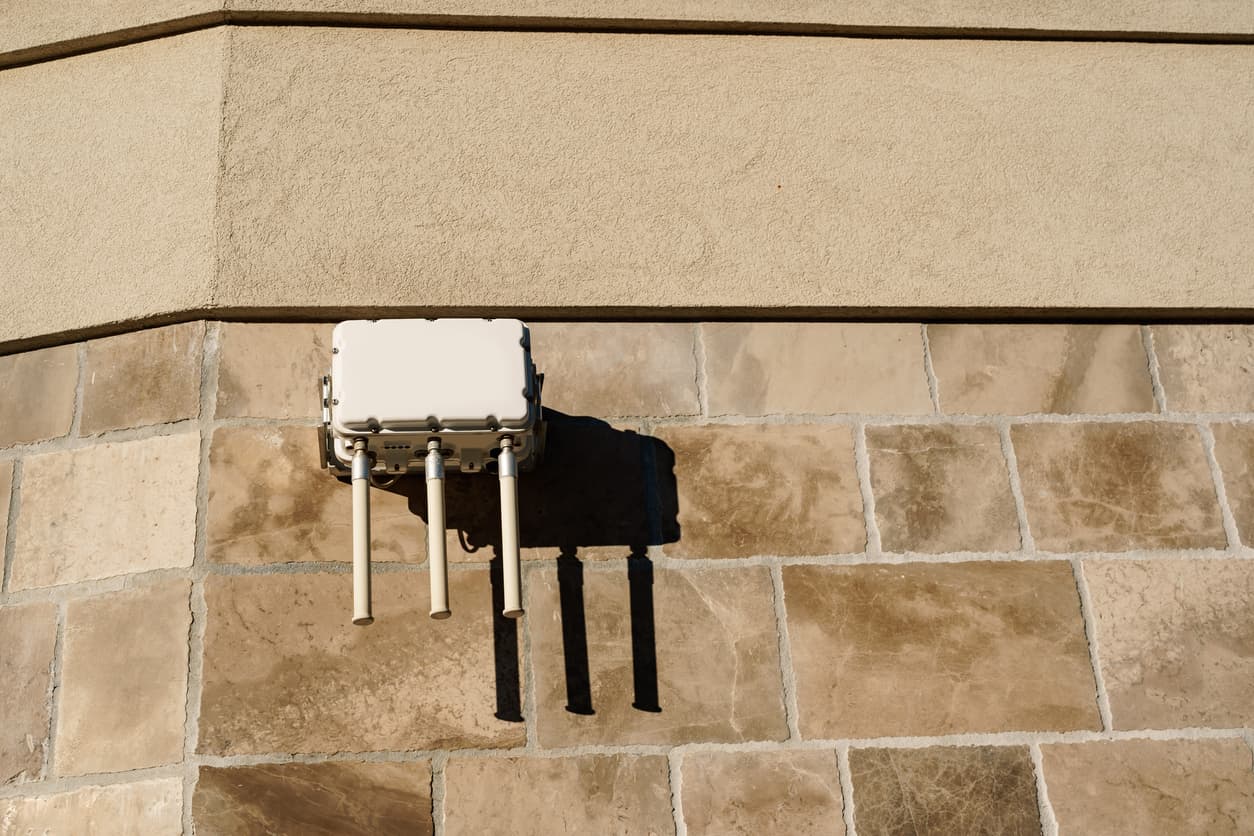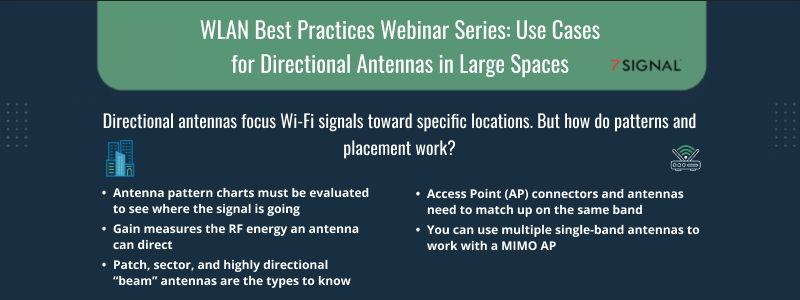
Blog
WLAN Best Practices Webinar Series: Use Cases for Directional Antennas in Large Spaces
Directional antennas focus Wi-Fi signals toward specific locations. But how do patterns and placement work?

Access point (AP) placement isn’t the only consideration when ensuring that Wi-Fi signals transmit properly throughout a large space. The directional antennas on those APs work sort of like flashlights that direct signals to specific places. This focus increases gain and reduces unwanted interference from other devices.
The patterns created with directional antennas matter. This post walks through what you need to know about planning with directional antennas on your APs.
Understanding antenna pattern charts
Antenna patterns are very important for outdoor spaces. You need to use the right external antenna to put the signal where the users are — where it’s needed and not where it isn’t.
To accomplish this, wide coverage in the horizontal plane and narrow coverage in the vertical plane are ideal. This configuration helps cover large, flat spaces. However, you can only see this type of pattern fully if you have a 3D view instead of just an azimuth view, which looks straight down from above. In the azimuth view, it looks like the signal is spread out, and you can see the antenna's gain. In contrast, the elevation view looks at the pattern from the side along the y-axis.
Understanding these patterns and picturing what they look like together in 3D tells you how antennas will focus the energy.
What is antenna gain?
Gain is a measure of an antenna’s ability to direct, or focus, RF energy. It doesn’t just apply to transmit antennas but also receive antennas. This is because the principle of reciprocity states that the receive and transmit properties of an antenna are identical.
It’s also important to learn “the 6 dB rule” for gain and range: adding 6 dB of gain, or transmit power, doubles the range, while subtracting 6 dB halves the range. So, a 6 dB antenna will have roughly double the range of a 0 dB antenna.
Gain is your friend. But always remember that if you’re focusing this energy and adding coverage in one direction, you’re taking it all away in another.
Directional antenna types
So, what kinds of directional antennas will you use for a large space? Here’s a look at three types:
- Patch antennas: approximately 3 to 15 dBi. These are usually square-like in shape and have more or less similar patterns in the horizontal and vertical planes. They are used frequently in large indoor spaces, like warehouses or lecture halls.
- Sector antennas are frequently used for large outdoor spaces. These have wide horizontal or narrow vertical patterns and are approximately 8 to 18 dBi. They get their gain by squeezing down vertically.
- Highly directional “beam” antennas are sometimes used outdoors and in other large areas, but mostly for point-to-point lengths. They’re dish-type antennas with sometimes very large panels. Highly directional beam antennas have very thin pencil beams that create a narrow pattern to really focus the signal. They have 10 to 30 dBi.
Dual-band antennas and APs
It’s also important to know how antennas should be connected to APs. Antennas can be cut for a single band, whether 2.4 or 5 GHz. But since most APs are now dual-band, antennas will have connectors that are both 2.4 and 5 GHz — and sometimes, they’ll have a separate set of connectors for the distinct bands.
Dual-band APs will often have connectors that are both 2.4 and 5 GHz, but not always, as connectors may be under software control. Crucially, it’s essential to match everything up—whatever connector you have on the AP, you must have on the antenna.
MIMO antennas
What if you have a multiple spatial stream AP, but the antenna with the pattern you need only has a single element? This is actually fine. You can gang multiple SISO (single input, single output) antennas together into a MIMO (multiple input, multiple output) antenna. MIMOs are really just groups of single antennas.
To do this, just follow these rules:
- Use a single type of antenna.
- Aim them all in the same area — MIMO Wi-Fi APs (802.11n or newer) will transmit control and manage traffic using a single antenna.
- Try experimenting with polarization, which is how the radio waves are oriented from each antenna. Good starting points are +45 and -45 degrees, vertical and horizontal or all vertical.
AP and antenna use cases
Let's walk through a couple of use cases to see this information in action.
For a commercial parking lot that’s 500 feet out from the edge of the building, here are the specs you might deploy:
- Antenna type: 90-degree sector
- Antenna1 gain: 15 dBi (AP)
- Cable and misc. losses: 4 dBi
- Antenna1 length: 3 feet
- Antenna2 gain: 0 dBi (client)
- Tx power: 15 dBm (32 mW)
- Frequency: 5.8 GHz
- Calculated RSSI @ 500 feet: -65 dBm (5 GHz)
These are common sector antennas. You need a lot of gain to reach the far edges of the parking lot, which calls for a narrow signal. Given that so much gain is required, a wider antenna pattern would make the vertical pattern paper-thin, and the antennas are harder to aim. Essentially, you’re trading off the size of the coverage area, vertically and horizontally, with gain.
In contrast, a large warehouse that needs Wi-Fi coverage has unique requirements compared to other indoor spaces with average proportions. Instead of mounting APs up in the ceiling, you can position them along the wall to fire down the aisles of the warehouse so that coverage isn’t blocked by everything stored in them. If the APs were up in those extremely high ceilings, they’d be too far from all the clients trying to connect down below.
Perfect placement is easier with wireless experience monitoring
Planning a network and maintaining its performance takes careful positioning of APs and an understanding of how directional antenna patterns work. And once you have everything in place, the only way to truly know how well the Wi-Fi is working is through detailed monitoring and testing.
7SIGNAL’s platforms provide client-level visibility into how a network performs at any given moment. Our sensors—Mobile Eye® and Sapphire Eye®—run continuous tests on devices to assess the end user’s experience and report on hundreds of KPIs. You'll know precisely what impairs performance and be able to solve issues proactively.
Contact 7SIGNAL to learn more about our solutions.
7SIGNAL® is the leader in wireless experience monitoring, providing insight into wireless networks and control over Wi-Fi performance so businesses and organizations can thrive. Our cloud-based wireless network monitoring platform continually tests and measures Wi-Fi performance at the edges of the network, enabling fast solutions to digital experience issues and stronger connections for mission-critical users, devices, and applications. Learn more at www.7signal.com.